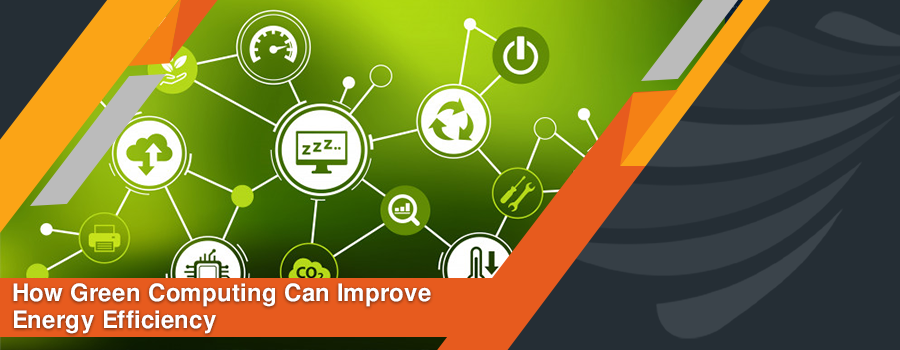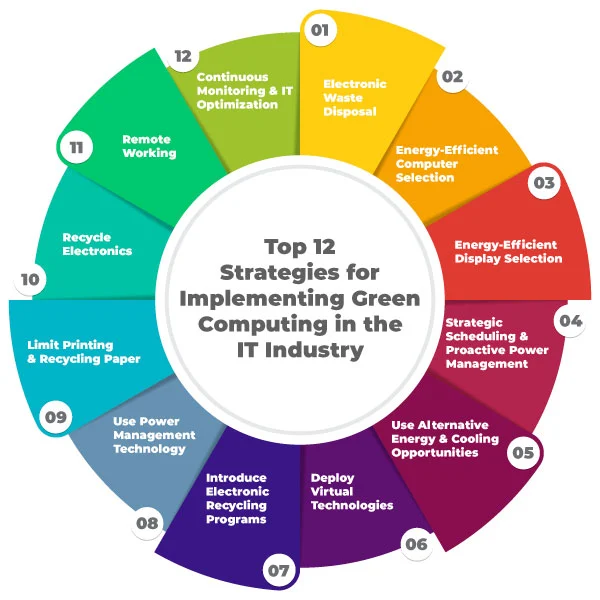In the accelerating technological revolution, we find ourselves at a crossroads where progress intersects with the technological revolution, resulting in several issues like pollution, extensive energy consumption, and carbon footprints.
Within this difficulty, a beacon of promise emerges – a promise that with the judicious use of technology, we can dive towards a transformative journey – a world to experience sustainability and energy efficiency. The complexity of balancing technological growth and environmental responsibility is sufficiently managed by adopting green computing. With green computing, we can enhance energy efficiency and play a part in making our future greener.
Remain connected with us as we are here to uncover different aspects of green computing and how it opens the door to a world where technology is a key to energy efficiency and sustainability.
Top of Form
What is Green Computing?
Green computing is called Information and communication technology (ICT) sustainability or sustainable computing. It adopts environmentally friendly practices in manufacturing, designing, disposing, and using hardware, software, and related services. Green computing aims to lessen the environmental impact of Information Technology (IT) systems and operations, including electronic waste production, energy consumption, and overall energy usage.
Why do We Need Green Computing?
We think computers are non-polluting and energy-efficient devices but substantially contribute to environmental pollution. ICT sectors contribute 1.8%–2.8% of global greenhouse gas emissions. Out of 250 billion global spending on powering computers, only 15% is utilized for computing tasks, while the remaining is wasted during idle periods (i.e., computers are on but not in use or are on standby mode). This idle energy consumption contributes to larger carbon emissions. By adopting green computing practices, which involve saving energy on computer hardware and optimizing computing practices, we can expect a reduction in carbon footprints.
Moreover, electronic waste is a growing concern. Electronic waste is known as discarded electronic or electrical appliances and is commonly known as end-of-life electronics. In 2019, 53.6 million metric tons of e-waste was generated globally. With green computing, we can expect reduced e-waste by promoting refurbishment, recycling, and adopting energy-efficient practices.
Top 12 Strategies for Implementing Green Computing in the IT Industry
The top 12 strategies or practical tips for implementing green computing in your IT business or organization are:
1. Electronic Waste Disposal
Electronic waste disposal involves adopting sustainable computing practices to manage discarded or obsolete electronic devices. Efficient waste disposal practices involve adherence to local, state, and federal regulations, refurbishing initiatives, and recycling programs.
Top of Form
2. Energy-Efficient Computer Selection
Selecting energy-efficient computers is a pivotal strategy to promote green computing practices. Choosing laptops over desktop computers significantly reduces energy consumption. With their lower Power Supply Units (PSUs) ranging from 30 to 90 watts, laptops exhibit a notable benefit in terms of energy conservation.
Amazingly, while ordinary desktop computers can reach up to 175 watts at their peak, laptop computers can only take up to 60 watts at their utmost. While laptops have lower PSUs, between 30 and 90 watts, desktop computers frequently have power supplies with maximum capacities beyond their system needs at 300 watts or higher.
Additionally, computers that depend on AC adapters rather than battery power are 20% more energy efficient. Compared to typical desktop computers, laptops can result in significant energy savings for users—potentially saving 50% or more on energy expenditures.
3. Energy-Efficient Display Selection
When choosing displays, it is crucial to choose liquid-crystal display (LCD) technology over conventional cathode-ray tube (CRT) monitors. LCD monitors contribute to a more environmentally friendly computing environment by using less energy and emitting less heat.
Moreover, the significant energy reductions are consistent with larger green computing projects. To create a digital landscape that is more ecologically sensitive and energy-efficient, thoughtful display choice not only lowers operating costs but also shows a dedication to responsible energy management.
4. Strategic Scheduling and Proactive Power Management
For energy conservation and sustainability, it is important to carefully plan when to use and turn off IT equipment and computers. If we keep such devices on without any reason, it is a complete waste of energy. Companies can optimize energy usage and operational effectiveness by allocating specific time slots for computer-related duties. In addition to scheduling, turning off servers, CPUs, and other equipment when not used for prolonged periods is a proactive step that greatly reduces energy use.
We can also integrate some advanced power-saving software. Such software provides strategic scheduling, allowing for efficient planning and regulating energy usage. The automated power schedules allow your computers to remain active only when needed. Features like PC power event tracking and logoff/logon tracking enhance energy conservation and save costs.
5. Use Alternative Energy and Cooling Opportunities
Investigating alternative energy sources to power data centers is necessary for diving toward sustainable computing. Adopting renewable options like hydroelectric and wind power aims to reduce dependence on conventional energy grids.
On the other hand, organizations are now embracing cooling technologies like geothermal cooling and other avant-garde approaches to reduce the environmental impact of data centers. Integrating such technologies is a strategic investment providing long-term environmental resilience of data centers and creating eco-friendly landscapes for data center operations.
6. Deploy Virtual Technologies
We can opt for virtual technology for servers and PCS smartly to conserve energy. By consolidating services, virtual servers eliminate the need for numerous physical machines and drastically lower the electricity needed to operate and cool the installed servers. This effort highlights the revolutionary power of virtual technology on resource optimization and service development while also being in line with ecologically conscientious practices.
7. Introduce Electronic Recycling Programs
Government, authorities, and businesses can take several initiatives to promote green computing practices. They can initiate electronic recycling programs to ensure efficient management of electronic waste. Outdated electronic devices from different manufacturers undergo processing via reputable recycling channels, contributing to responsible waste disposal and environmental sustainability.
8. Use Power Management Technology
An operating system can remotely manage the power-saving elements of its hardware resources using ACPI (Advanced Configuration and Power Interface). This allows a system to turn off hardware, such as screens and storage units, after certain amounts of inactivity. On the other hand, a computer can hibernate when most of its components—including the processor and RAM—are turned off.
It allows you to experience a reduction in electricity consumption. Increase energy efficiency and lower negative impact on the environment. Recent research also showed that power management technologies like automatic shutdowns for idle devices can lower energy usage by 50%. It allows you to manage power resources more intelligently and ensure that gadgets work optimally while using the least energy possible.
9. Limit Printing and Recycling Paper
One of the most important tactics you can use as a green computing initiative is switching from paper to electronic workflow. You can greatly reduce environmental effects and save money by digitally producing, editing, and sending papers. Adopting email attachments instead of faxing and duplex printing techniques, motivated by research indicating the possibility of 800 tons of paper saved annually—or more than $7 million—aligns with our dedication to sustainability and conscientious resource management.
10. Recycle Electronics
Repurposing, reusing, and recycling—the three Rs—act as a framework for reducing technological waste and promoting environmental sustainability. You can contribute significantly to ethical and environmentally acceptable disposal methods by participating in recycling programs for electronic waste, such as printer cartridges and outdated cell phones, or by donating working gadgets to charity organizations and schools. By adhering to these guidelines, you can help reduce electronic waste and develop a computing environment that is more ecologically friendly.
11. Remote Working
One of the most important strategies for a more sustainable workplace is to support telecommuting. Accepting remote work helps lessen the environmental effect of regular trips and the demand for office space, which reduces heating, cooling, and on-site computer usage. In addition to its potential to reduce the spread of infectious diseases, telecommuting offers businesses and employees significant financial benefits. As such, it can potentially revolutionize the workplace by fostering a more flexible and environmentally conscious work environment.
12. Continuous Monitoring and IT Optimization
Thoroughly tracking outcomes is critical while pursuing green IT efforts. You can assess success by comparing data against benchmarks, like monthly electricity consumption. For example, a notable reduction in power use demonstrates a real environmental benefit and effectively lowers your organization’s carbon footprint. By embracing ongoing IT improvement, you can guarantee flexibility and creativity. Dedication towards continuous optimization and outcome monitoring is a tangible path towards a more sustainable and environmentally friendly organizational footprint.
What Steps can you take At Your Home to Contribute to Green Computing?
As an individual, you can also contribute to green computing. Following are the steps you can take at home to contribute towards green computing:
1. Monitor Management
It includes turning off or placing your monitor in sleep mode when not in use and adjusting the brightness to use less energy. Avoid using screen savers as they are superfluous and power-consuming.
2. Peripheral Awareness
To save energy, turn off peripherals like speakers and scanners while not in use. Similarly, ensure your printer supports energy-saving standby modes and turn it off until needed.
3. Practices for Smart Printing
To pick and print only the most important text, preview before printing. Use less paper by choosing double-sided printing, and consider if you need to print or if your work can be done digitally.
4. Paperless Communication
Use paperless communication techniques like viewing emails, papers, and web pages on a screen instead of printing hard copies whenever feasible.
5. Energy conservation
Avoid leaving your computer on all night. Turn off your display, printer, and other electronics when not used. To further reduce energy consumption, invest in energy-efficient gear.
6. Recycling Initiatives
Take part in toner, computer, mobile, and printer recycling programs. This easy action has a big impact on cutting down on technological trash.
7. Telecommuting and Virtual Meetings
Consider telecommuting whenever possible to reduce the need for in-person travel and the corresponding energy usage. You can use Voice over Internet Protocol (VoIP) and video conferencing for meetings.
8. Use Power Strips
Adding power strips to your home office setup is a straightforward but efficient method to improve energy economy. Put all your peripherals—including your printer, monitor, and computer—into a power strip so you can turn them all off with a single switch when not in use. This simplifies controlling energy use in your home office and helps reduce the need for standby power.
The Benefits of Green Computing in Improving Energy Efficiency
The most promising benefits of green computing in enhancing energy efficiency are:
1. Efficient Management of Energy Consumption
Green computing helps in the proficient management of energy consumption. By deploying advanced optimization strategies in data centers and relying on energy-efficient hardware and cooling mechanisms, we can experience a reduction of up to 30% in overall energy usage.
2. Brand Recognition
Green computing initiatives offer a positive brand image for your organization. As the literacy rate increases, customers are aware of the importance of sustainability and a greener future, and, therefore, they prefer those businesses that are actively involved in green computing practices. Also, the company can gain a competitive advantage.
3. Reduction in Carbon Footprints
Green computing shows wonders in reducing environmental impact. We can mitigate our carbon footprint by integrating renewable energy sources, shifting towards digital activities, adopting energy-efficient IT equipment, and optimizing energy consumption.
4. Extended Hardware Span
Green computing supports the extension of the hardware span. With the adoption of efficient cooling mechanisms, resource optimization, efficient energy utilization, and maintenance, we can not only extend the hardware span but also save the cost of replacement and play a positive role in the environment.
What is the Future of Green Computing?
Green computing promises a greener future, and efficiency can further increase with the integration of advanced technologies and positive initiatives:
1. AI-powered Optimization
Data center operations, resource allocation, and energy usage will all be greatly enhanced by artificial intelligence (AI). Envision AI systems to forecast cooling requirements, optimize server workloads for effectiveness, and even settle contracts for renewable energy sources.
2. Quantum Computing Efficiency
Although in its infancy, quantum computing promises to transform fields as diverse as materials science and medicine development. Because of its low energy requirements, complicated simulations and scientific studies may use much less electricity.
3. Edge Computing and the Internet of Things (IoT)
Data processing at the network’s edge, closer to the source, can significantly lower the energy required for information transmission and reception. This will be essential for the increasing Internet of Things devices, such as connected cities and smart homes.
4. Green Hardware and Materials
Hardware is undergoing a green transformation, with lighter, more energy-efficient CPUs and biodegradable electronics among its features. Further research into environmentally friendly materials and recycling techniques will help to reduce the negative effects of electronics manufacture.
5. Circular Economy Principles
Extending beyond recycling, the circular economy strives to extend the life of materials. This can entail giving outdated electronics a makeover, increasing longevity, and creating simple goods to disassemble and reuse.
Success Stories of Green Computing Initiatives to Improve Energy Efficiency
Several companies have taken green computing initiatives. Some of them are:
1. BrainBox AI
By using artificial intelligence and cloud computing to improve the efficiency of heating, ventilation, and air conditioning (HVAC) systems, BrainBox AI is leading the way in the green building revolution. BrainBox AI automates the functioning of individual HVAC system components by fusing deep learning algorithms with current technology. This provides a proactive, detailed method of controlling a building’s energy usage. This cutting-edge technology greatly increases occupant comfort while reducing carbon footprints by 20 to 40% and lowering overall energy expenses by up to 25%.
The system is a prime illustration of how technology can support efficient and sustainable behaviors in the built environment because of its easy installation, non-intrusive design, and capacity to produce savings without requiring an initial capital expenditure.
2. Apple
Apple has made significant progress toward carbon neutrality by running all of its stores, offices, and data centers entirely on clean electricity. The pledge also includes product packaging, where all plastic will be removed by the end of the next year. Furthermore, Apple sets the standard for ethical material sourcing by utilizing only 100% recycled aluminum in its MacBook, Apple TV, and Apple Watch enclosures. Apple has prioritized ocean shipment over air transport to reduce transportation emissions, resulting in an astounding 95% reduction.
Apple is committed to worldwide programs, such as carbon removal initiatives that entail the restoration of mangroves and forests in places like Paraguay, Brazil, Colombia, and Kenya. Prioritizing water conservation has resulted in a 63 billion-gallon decrease in usage. Apple’s diverse strategy demonstrates a deep dedication to environmental responsibility and establishes a high bar for environmentally friendly activities in the tech sector.
3. Google
Being a major player in the digital industry, Google is seeking sustainable practices in both product creation and operational effectiveness. Compared to most other data centers, Google Cloud is known to be among the world’s most energy-efficient, using only 50% of the energy. Considering its enormous size and operations, the company’s 35% reliance on renewable energy represents a significant commitment to greener methods. Large-scale tech organizations looking to reduce their environmental impact might use Google’s comprehensive strategy as a model.
4. Winbond Electronics
Winbond Electronics – Taiwan-based semiconductor manufacturer actively integrates environmental, social, and governance (ESG) factors and uses cutting-edge techniques like low-temperature soldering to minimize its carbon footprint.
Reducing greenhouse gas emissions by 229,245 metric tons, recycling 7,212 metric tons of waste with a 93% recovery rate, and reusing 10.59 million cubic meters of water are just a few of the outstanding sustainability milestones the company accomplished in 2022. To reduce energy use, cut carbon emissions, and obtain ISO certifications about wafer carbon footprints, Winbond is actively involved in industry activities. The company’s dedication establishes a praiseworthy benchmark for sustainability within the semiconductor industry.
Conclusion
Green computing initiatives help to reduce energy consumption, save costs, and lower carbon footprints. Companies that participate in it can also extend the lifespan of their software and hardware and gain a positive brand image and recognition. Green computing also helps achieve sustainability goals and attract socially conscious customers. With the ever-increasing demand for energy conservation and sustainability, we must alter our conventional practices and strive for a greener future.





